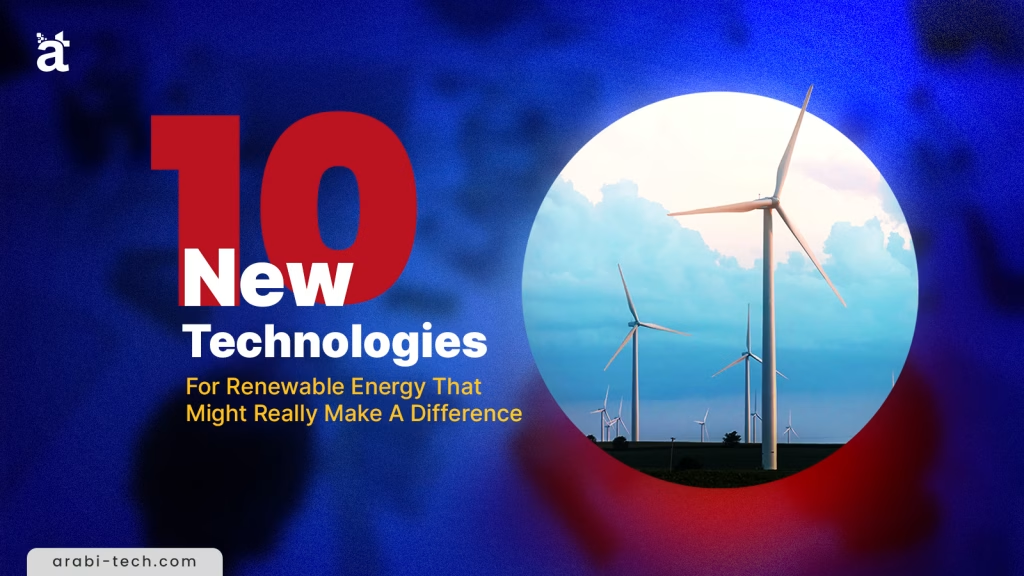
10 New Renewable Energy Technologies That Matter – Renewable energy technology is growing quickly, which is a good sign for long-term power.
As the world works to fight climate change and cut down on carbon pollution, new energy options are being developed.
Ten new tools for sustainable energy could change the way energy is used around the world.
Audio article :
Table of contents
- Audio article :
- 1. Floating Solar Farms: Harnessing The Power Of Water
- 2. Offshore Wind Power: Tapping Into Stronger Winds At Sea
- 3. Green Hydrogen: A Clean Fuel For The Future
- 4. Perovskite Solar Cells: The Next Generation Of Solar Technology
- 5. Bioenergy with Carbon Capture and Storage (BECCS): A Path to Negative Emissions
- 6. Advanced Geothermal Systems: Unlocking the Earth’s Heat for Clean Energy
- 7. Artificial Photosynthesis: Mimicking Nature To Produce Clean Energy
- 8. Tidal and Wave Energy: Harnessing the Power of the Ocean
- 9. Energy Storage Systems: Revolutionizing The Renewable Grid
- 10. Solar Thermal Energy: A High-efficiency Approach To Harnessing Heat
- Conclusion
1. Floating Solar Farms: Harnessing The Power Of Water
Floating photovoltaic (FPV) systems, which are another name for solar farms, are a new way to make clean energy in lakes, rivers, and the ocean Floating solar farms use the surface area of bodies of water to make clean energy without competing for land resources. The water around moving solar panels keeps them cooler, which makes them work better than systems that are fixed to the ground,
2. Offshore Wind Power: Tapping Into Stronger Winds At Sea
Offshore wind power is another potential way to get energy from sustainable sources. Of course, offshore wind farms are put in areas of water that are far from the shore, where the winds are stronger and more stable. The windmills for these farms can be put on mobile platforms, which lets them work in the middle of the ocean without needing stable support, New developments in offshore wind technology have made windmills bigger and more efficient so that they can make more energy with fewer units.
This method works best in parts of Asia and Europe that don’t have much land but have long coastlines. Offshore wind farms make clean energy that doesn’t hurt nearby species much, which is very good for the environment. As technology improves, offshore wind farms could change the way green energy is made and help the world become less carbon-based.
3. Green Hydrogen: A Clean Fuel For The Future
Green hydrogen could change the way cars are made and how power is made, Green hydrogen is made by electrolyzing water with energy that comes from renewable sources like the sun, wind, or water. Water can be split into hydrogen and oxygen without giving off any pollution, which makes it a clean and long-lasting fuel. Green hydrogen could be used instead of fossil fuels in heavy industrial and long-distance transports, which are hard to power with electricity.
4. Perovskite Solar Cells: The Next Generation Of Solar Technology
One of the most exciting new solar energy solutions is perovskite solar cells. Perovskite solar cells with a crystal structure can be made more easily and for less money than silicon-based ones. Perovskite solar cells might be able to turn sunshine into energy as efficiently as or more efficiently than silicon-based cells, which makes them a good choice. The major reasons are that they absorb a lot of light and are easy to make into lightweight, bendable forms.
5. Bioenergy with Carbon Capture and Storage (BECCS): A Path to Negative Emissions
New biofuel that stores and occupies carbon BECCS uses renewable organic energy to take CO2 out of the air. Bioenergy can be made from algae, farm waste, or wood to power heaters or fuel for cars.”BECCS“uses carbon capture technology to collect “CO2″ emissions from burning wood before they are released into the air.”BECCS” could change how we fight climate change. especially in big businesses and flights.
BECCS lets biomass energy be made, which could help build a cycle bioeconomy that uses garbage organic matter to make energy. BECCS could also pay businesses that are hard to power or decarbonize with standard green energy sources.
6. Advanced Geothermal Systems: Unlocking the Earth’s Heat for Clean Energy
Geothermal energy is a reliable and long-lasting source of power, and new technologies are making it more useful in more ways. In traditional geothermal power plants, energy is made from the heat in the ground. How well these pools work depends on where they are located and how the rock is formed. However, advanced geothermal systems (AGS) get heat from more places underground, which makes geothermal power more available to more people.
7. Artificial Photosynthesis: Mimicking Nature To Produce Clean Energy
Artificial photosynthesis is a new method that tries to copy the way plants use sunshine, water, and carbon dioxide to make oxygen and glucose. Instead of food, artificial photosynthesis makes hydrogen power or chemical fuels like methane. This method could cut down on carbon pollution and make clean energy that can be used for a long time. Instead of solar panels making power, artificial photosynthesis could change the way energy is used by turning sunshine into chemical fuels that can be stored and moved.
8. Tidal and Wave Energy: Harnessing the Power of the Ocean
More and more people are using tidal and wave energy devices, which use the huge potential of water to make electricity. Tidal and wave energy systems get their power from the ocean’s tides and waves. This is different from sun and wind energy, which depend on natural forces that change over time. A steady source of energy that can be used along with fluctuating green sources is a big plus.
9. Energy Storage Systems: Revolutionizing The Renewable Grid
Energy storage options help a lot of people use green energy by making it possible for solar, wind, and other sustainable sources to work when they’re needed. Wind and solar panels work well, but they only give you power when the weather is good and at certain times of the day or year. To keep a steady and reliable energy supply, energy storage systems must store extra energy when production is higher than demand and release it when production is low.
10. Solar Thermal Energy: A High-efficiency Approach To Harnessing Heat
Solar thermal energy is a new technology that turns sunshine into heat instead of power. Unlike photovoltaic PV solar cells, solar thermal devices use the heat from the sun to make steam or hot air. Turbines can be powered by heat to make electricity or heat homes, companies, and factories.
Solar power that is focused on Solar heat energy could be used in CSP plants. Mirrors or glasses that direct sunlight onto a receiver. The heat from the sunshine creates high-pressure steam. A turbine turns, making electricity. In areas with a lot of direct sunlight, CSP plants may work well during the day and use thermal storage to make electricity at night or when it’s cloudy.
Conclusion
Renewable energy technology will change the way energy is used around the world by making fossil fuels less harmful and longer lasting.
New technologies like mobile solar farms, green hydrogen, advanced geothermal systems, and algae biofuels all help fight climate change and use less nonrenewable resources. As these technologies get better and easier to get, they could speed up the growth of low-carbon products. With more money and study, the green energy movement will create a cleaner and more reliable energy system for future generations.



